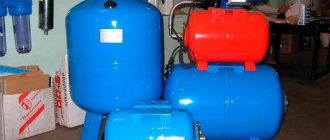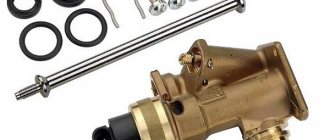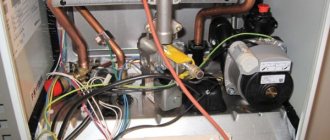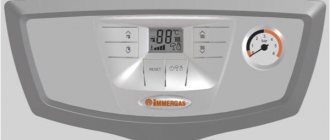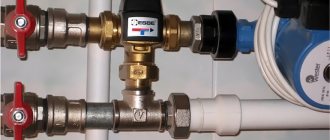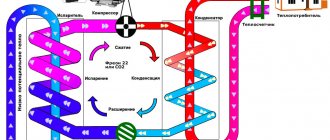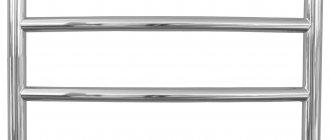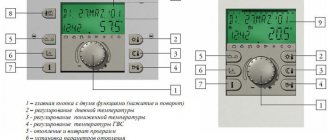Design and principle of operation of a three-way valve for a boiler
Three-way valve that regulates the temperature of the coolant in solid fuel boilers
The design of a thermomixing valve for a solid fuel boiler or another can vary significantly depending on the purpose of the element and the manufacturer, but the principle of operation remains unchanged. The thermostat has three outputs: one of them is always open, and the others are closed completely or partially during operation. Based on the number of outlets, the valve is called a 3-way valve. It is used to mix or separate liquid or gas flows, thereby adjusting the coolant temperature and switching from one circuit to another.
It looks like a tee. The internal structure is represented by a locking mechanism and a rod that ensures its movement - these are the main elements. Some designs have two seat rings that secure the bolt. It is possible to add other elements.
Three-way valve device
Any valve has three holes: two incoming and one outlet. Inside there is a special drive that regulates the incoming flows.
Design and principle of operation of a three-way valve
The passages between the three chambers, which are constructed by casting inside a brass body with a triple pipe, are blocked by poppet valves. The latter are arranged on one plane - a rod, which comes out of the body on the fourth side.
A three-way mixing valve for a boiler functions in such a way that when the stem is pressed, a path will open for one flow and evenly close the path for another. At the end of everything, water of the required temperature will be obtained in the mixing chamber of the valve. Through a third pipe, water is removed from the brass body.
Using a thermal head with an external temperature sensor, the degree of pressure on the rod and control are carried out.
In a separating valve, everything happens in the same way, only when you press the rod, the flow branches into two, and in the switching element, the electric drive changes the path of movement.
Adjusting a three-way valve using a thermostatic head with a regulator is a fairly common method, since it is quite accurate and easy and, moreover, does not use electricity.
There is also a four-way mixing valve for heating.
Types of valves
The functionality of the valves varies. Based on this feature, three-way valves are divided into switching, mixing and separating.
Mixing
The principle of operation of a three-way valve in a heating system
A cold flow is supplied to one input, and a hot flow to the other. At the outlet they are mixed, forming one stream of a given temperature. Thus, thanks to the thermal mixer, the temperature of the coolant is regulated, in particular, the return flow is mixed into the coolant at the outlet of the boiler. To do this, the valve is installed on the return of the heating pipe.
Separating
Dividing valves are also called distribution valves. They split one stream into two. Used in hot water supply systems and air heater piping.
Switching
Switching or changeover switches switch from circuit to circuit, for example, from heating to hot water supply. Switching is carried out using an electric drive.
Job
The principle of operation of the valve is to mix water flows with different temperatures.
Why do you need to do this? Without going into technical details, we can answer this way: to extend the life of the heating boiler and make it more economical.
A three-way valve mixes heated water with cooled water after passing through the heating devices and directs it back to the boiler for heating. Everyone can answer the question of which water to heat faster and easier - cold or hot.
Simultaneously with mixing, the valve also separates the flows. There is a natural desire to automate the management process itself. For this purpose, the valve is equipped with a temperature sensor with a thermostat. In this case, an electric drive works best here. The quality of functioning of the entire heating system depends on the drive device.
Methods of controlling three-way valves
Three-way valve with thermostatic head
Three-way valves according to the control method are:
- autonomous;
- manual;
- thermostatic;
- with electric drive.
If there is no control option, the thermal valve is of the autonomous type. It is set by the manufacturer to a certain coolant temperature, i.e. the temperature in the system will always be constant. The main advantages of such devices are low cost and the ability to maintain the same temperature. But you cannot change the preset settings, so the characteristics of the valve must meet the requirements of the system; it will have to be selected more carefully.
A manually operated three-way valve is equipped with a manual adjustment device, which can be a control panel, a rotary knob or a valve. Adjustment control is carried out using special marks - a scale. Compared to a stand-alone regulator, a manual three-way thermal valve is more functional: it allows you to change the temperature regime depending on specific needs and will maintain the temperature at a given level. However, this valve “does not know how” to respond to changes in coolant temperature to changes in environmental conditions.
Electrically actuated valve
The design of the product with a thermostat includes a thermostat. The gas or liquid medium located inside it reacts to changes in the temperature of the coolant. When it heats up to a preset temperature, the pipe with the hot coolant is closed. According to the type of power supply, this type of valve can be mechanical or electronic. Mechanical ones operate autonomously, while electronic ones require an electrical outlet or periodic battery replacement. Although this inconvenience is fully compensated by the advantages.
Including a thermostatic valve for a solid fuel boiler in the system allows you to automate the process of changing the temperature according to the time of day and days of the week. The cost of a three-way element with a thermostat is higher than the cost of simpler analogues.
The most advanced models are thermal valves with electric drive. In order for them to work continuously, it is necessary to install an uninterruptible power supply. The flow of cold or hot coolant is regulated using a controller, which records temperature deviations from the set values, and a servo drive. The outlets are not completely blocked, but the volume of coolant changes. Thanks to the automatic operation, the heating circuit is always heated evenly, and the coolant temperature always exactly corresponds to the set one. The possibility of changing the mode is also present, but you need to be prepared for high consumption of resources: coolant and electricity. You will have to pay more for the thermal valve itself. A fully automatic device is more expensive.
Kinds
They differ in the way they are controlled.
Valves can be roughly divided into:
- with manual control;
- with thermal head;
- with electric drive;
- hydraulic;
- pneumatic.
In a private home, an electric valve would be most acceptable. Sensors installed inside issue a command through the controller to the drive if the controlled water parameters change. As a result, it becomes warmer, or vice versa, cooler.
The thermo-mixing effect occurs automatically. It does not matter which boiler is installed in the system - gas or solid fuel.
If it is not possible to install an adjustable valve in the heating system, then the best solution in this case would be a valve with a thermal head.
Purpose and functions
Mixing of flows is necessary so that condensation does not form in the boiler due to cold return.
A three-way valve is installed for the following purposes:
- To prevent cold coolant from entering the boiler and causing condensation to form on the inner walls of the firebox. In addition, if a hot water boiler uses a cast iron heat exchanger, it may crack due to temperature changes.
- To regulate the coolant temperature in the circuits. This need may be due to the complexity of the system, where the temperature requirements for each circuit vary. When connected to a heat accumulator, as well as when the coolant is used in the heat exchanger of a ventilation air handling unit, which is part of the air heating system.
- To be able to control the heating of the coolant in the heated floor circuit. The optimal temperature for heated floors is no more than 50°C. The temperature of the coolant supplied from the boiler can exceed this indicator by 10-35°C. The cooled water that has passed through the heated floor circuit will be mixed with the coolant from the boiler; a three-way valve installed on the distribution manifold will ensure that the return is mixed.
The regulator should not be installed if the system operates several heating sources alternately; if the length of each water floor loop is no more than 50-60 m (then RTL heads are installed instead of a three-way valve); if the heating is organized using a gravity system.
Installing a three-way valve in a heating system
The thermostatic mixer is installed in the heating system in the mixing unit with single or multi-circuit heat distribution. There may be several such circuits. The schematic diagram will not change. Only new elements will be added.
For example, a mixing unit. The presence of an additional coolant distribution circuit is its main distinguishing feature. Why is it needed? For connecting additional heat consumers. For example, heated floors.
When performing installation work to install the valve, you must remember that it is installed in front of the system pump. The performance of the entire system depends on compliance with this requirement.
When cutting into the valve, you need to make sure that welding waste (slag, drops of molten metal) does not get into it. It is also necessary to provide for the possibility of easy removal of the valve during its operation. This action will be required when periodically checking its performance.
Choice
To choose the right valve, you need to take into account many different nuances.
- First of all:
- number of circuits in the heating system;
- design feature of valve control;
- inlet pipe diameter;
- throughput of heating system pipelines;
- the material from which the valve is made.
It’s easy to figure out the number of heating system circuits yourself. With other moments of choice, everything is much more complicated. To find out how a three-way valve works and works, just delve into this issue.
And in order to correctly determine even its dimensions, it is necessary to have a concept in thermodynamics.
At its core, a 3-way valve is a valve with a thermostatic head. With an automated control drive, it is able to distribute hot water flows in the desired direction and in the required quantity.
Valves are not able to cope with such a task, which indicates the need for a three-way valve in the heating system. Using a valve in the system, there is no need to come up with some kind of remote control panel to control it. Everything is done without human intervention.
Basic parameters when choosing valves
Products made of brass have an increased service life and do not crack due to mechanical stress.
The three-way valve must best correspond to the features of the system, therefore, when choosing, you should check all the parameters: structural design, technical characteristics.
- First of all, it is necessary to cut off options that are made of inappropriate metal. Inexpensive silumin three-way valves are immediately excluded, since the aluminum-silicon alloy has low strength. Such thermal valves crack and literally crumble during operation.
- Cast iron 3-way valves are not subject to corrosion and are quite durable under static loads, but a single mechanical impact or a sudden temperature change can cause it to break. Such devices cannot be repaired.
- Steel devices are inexpensive and durable, but will rust over time. To protect against corrosion, products are coated with nickel and chromium.
- Thermal valves made of stainless steel are more expensive, the metal is not subject to oxidation and corrosion, so they will last a long time.
- Brass and bronze three-way valves are preferred because the material best meets the requirements for service life and corrosion. Brass products cannot be installed in a system where the coolant is heated to temperatures exceeding 200 degrees. Bronze devices are built into a heating circuit made of copper.
The internal locking mechanism in some products may be ceramic. When operating conditions are observed, ceramics perform at their best: they do not rust and last a long time. But the coolant in the system must be of high quality. If there are mechanical inclusions, ceramic elements will quickly fail.
For heated floors, it is preferable to install valves with a servo drive.
The type of valve is selected taking into account the characteristics of the system:
- To protect the boiler from condensation, a valve with an internal thermostat set to a constant coolant temperature is sufficient.
- If the system consists of several branches and it is necessary to control the heating of each, install a regulator with a thermal head and an external sensor.
- When assembling the system yourself, it is recommended to install a mixing valve. It is easier for a beginner to understand the scheme of its operation, how to install it and remove it.
- Saddle-mounted varieties, unlike rotary ones, allow you to more accurately regulate the coolant temperature and pressure.
- For heated floors, electric models with a servo drive are recommended.
- For DHW - separating valves, for heating - mixing valves.
The diameter of the thread on the valve must match the diameter of the heating pipes.
Regarding technical characteristics, it is necessary to take into account:
- connection method - can be threaded or flanged;
- internal diameter of pipes - must match the diameter of the pipes at the installation site;
- maximum working pressure;
- maximum coolant temperature at the installation site;
- average water consumption per hour - conditional throughput;
- dynamic control range (30:1, 50:1, 100:1) - indicates the difference in throughput when the shutter is fully closed and half-open.
Valves with a 100:1 range show greater adjustment options.
Models depending on coolant volume, ESBE brand
The data is indicated in the product passport. In order to correctly select the valve according to the system parameters, it is also necessary to calculate the coolant flow rate in the installation line, because the valve must pass the required volume of water at different positions of the rod.
Last but not least, the parameter is the manufacturer. Popular:
- Esbe (Sweden);
- Danfoss (Denmark);
- Honeywell (USA);
- Herz Armaturen (Austria);
- Caleffi (Italy);
- Icma (Italy);
- Valtec (Russia).
It is recommended to choose products from well-known brands, then you can be sure that the markings and declared characteristics correspond to the actual parameters of the three-way valve.
Construction of a double-circuit gas boiler
In order to understand the principle of operation of a gas double-circuit boiler, it is necessary to understand its structure. It consists of many individual modules that heat the coolant in the heating circuit and switch to the DHW circuit. The coordinated work of all components allows you to count on trouble-free operation of the equipment. Knowing the structure of a double-circuit boiler, you can understand its operating principle.
We will not consider the design of double-circuit boilers with precision down to the screw, since it is enough for us to understand the purpose of the main components. Inside the boiler we will find:
Design of models with two circuits: heating and DHW circuit.
- The burner, located in an open or closed combustion chamber, is the heart of any heating boiler. It heats the coolant and generates heat for the operation of the DHW circuit. To ensure accurate support of the set temperature, it is equipped with an electronic flame modulation system;
- Combustion chamber - the above burner is located in it. It can be open or closed. In a closed combustion chamber (or rather, above it) we will find a fan responsible for pumping air and removing combustion products. It is this that is the source of quiet noise when the boiler is turned on;
- Circulation pump – ensures forced circulation of coolant through the heating system and during operation of the DHW circuit. Unlike the combustion chamber fan, the pump is not a source of noise and operates as silently as possible;
- Three-way valve - this is the thing that is responsible for switching the system to hot water generation mode;
- The main heat exchanger - in a double-circuit wall-mounted gas boiler, it is located above the burner, in the combustion chamber. Here the coolant used in the heating circuit or in the DHW circuit for heating water is heated;
- Secondary heat exchanger - this is where hot water is prepared;
- Automation - it controls the operating parameters of the equipment, checks the temperature of the coolant and hot water, controls modulation, turns on and off various components, monitors the presence of flame, records errors and performs other useful functions.
At the bottom of the buildings there are pipes for connecting the heating system, cold water pipes, hot water pipes and gas pipes.
Some models of gas double-circuit boilers use dual heat exchangers. But the operating principle remains almost the same.
You may notice that the design of the geyser differs only in the absence of a heating circuit.
We found out the structure of a double-circuit wall-mounted gas boiler - it seems a little complicated, but if you understand the purpose of certain components, the difficulties will disappear. Here we can note the similarity with a gas instantaneous water heater, from which a burner with a heat exchanger remains here. Everything else is taken from wall-mounted single-circuit boilers. An undoubted advantage is the presence of a built-in piping - this is an expansion tank, a circulation pump and a safety group.
When analyzing the operating principle and design of a gas double-circuit boiler, it should be noted that water from the DHW circuit is never mixed with the coolant. The coolant is poured into the heating system through a separate pipe connected to the heating. Hot water is prepared using part of the coolant circulating through the secondary heat exchanger. However, we will talk about this a little later.
Simplified budget elements
Cheap models made of silumin have low strength and are damaged during operation.
Three-way valves of the autonomous type are considered simplified. Their internal structure is truly simplified, since neither a thermal head with a controller nor a rod are provided in them. The thermostatic element is installed internally and is designed to operate at a specific temperature (often 50°C or 60°C). It is no longer possible to change the settings; the flow temperature at the valve outlet will always correspond to the specified ±2°C. This option is for those who install a valve in simple heating systems and want to save money. The cost of simplified elements is approximately 30% lower than the average cost of the bulk of regulators.
A thermostatic three-way valve is necessary in complex systems that include several circuits: hot water, heating, underfloor heating. It allows you to save fuel by more efficiently using the thermal energy generated by the boiler. Despite many advantages, installing a valve is not always justified, so you should consult with a specialist regarding the advisability of installing it.
Which heat exchanger to choose?
When choosing a double-circuit heating boiler, you have to decide whether to buy a boiler with a bithermic heat exchanger or with separate heat exchangers. You will have to decide, because there is no clear answer. Here are the criteria:
- With bithermic, water for hot water heats up faster, since heating comes directly from the burner flame. That is, you spend less water while it heats up, and less gas and electricity is wasted.
- Since the heating is direct, the temperature is maintained more accurately.
Deciding on a heat exchanger is not so easy - For models with separate heat exchangers, they are less likely to clog. In addition, it is possible to replace only one of the heat exchangers.
- If the bithermic “flies”, both heating and hot water supply do not work. In a boiler with separate heat exchangers, if the secondary one fails, the heating will continue to operate.
- As practice shows, it can be very difficult to flush a “neglected” bithermal heat exchanger. Plate-type ones, after washing, may be inoperative (the plates are at a distance of 2-3 mm from one another). But if the heat exchanger is of a collapsible type, it can be disassembled, cleaned and put back together. So problems can only arise with brazed plate heat exchangers. We recommend reading the article on how to clean a heat exchanger.
- Bithermic ones have less throughput - the pipe is divided into sections. To ensure the same water consumption, it is necessary to take more expensive models (due to the greater consumption of expensive metals for more efficient heat exchangers).
- In summer mode (without heating), a bithermic heat exchanger is more economical.
- As a rule, a bithermal heat exchanger costs more than two separate ones.
Opinion of the site editors . We recommend purchasing heating boilers with separate heat exchangers.
Now you not only know how a double-circuit boiler works, but also what heat exchangers can be installed in it.

